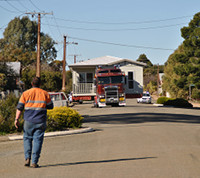 Before we launch into this topic, I just want to clear up the difference between kit houses and transportable or relocatable houses. Kit houses are a lot cheaper than transportable or relocatable houses but importantly, when you buy one you are simply buying the materials to make the outer shell of the house. You still have to do all the building yourself, organise the wiring yourself, buy a kitchen, pour a slab for the floor. Banks generally won't finance them. I don't advocate kit homes myself, I think they are great for people who are tradespeople and can build them themselves with their own funds, but in this section I am not discussing them at all.
Before we launch into this topic, I just want to clear up the difference between kit houses and transportable or relocatable houses. Kit houses are a lot cheaper than transportable or relocatable houses but importantly, when you buy one you are simply buying the materials to make the outer shell of the house. You still have to do all the building yourself, organise the wiring yourself, buy a kitchen, pour a slab for the floor. Banks generally won't finance them. I don't advocate kit homes myself, I think they are great for people who are tradespeople and can build them themselves with their own funds, but in this section I am not discussing them at all.
Conversely, a transportable, prefabricated or relocatable house is fully built by a builder, and is moved to your property on the back of a truck. Once it gets there, it is set down on stumps and connected to power, water, electricity and any other services you need. The build time only takes a few weeks and the connection process can happen in a few days. Most banks will finance transportable houses with some caveats, mainly that all the connection fees are included in the loan to ensure that the house is livable and the bank isn't holding a toxic asset. Expect to pay around $10,000 for connection fees, more if you need a septic tank installed or large distances of trenching. Then add around $4000-6000 to get the house delivered.
Because transportable houses are built offsite on the builder's property they are typically built in around 6 weeks, but with considerable lead time to finalise any choices of colours, materials etc. Most builders will require a small initial deposit to cover expenses like council approval and soil tests, and will ask for the remainder of the money after the house is delivered. This process is perfect for someone on a low income, as they don't need to pay for a construction mortgage at the same time as paying for rent or the mortgage on their previous house. If you can only borrow a small amount and cannot afford two loans at once for regular construction, this may be ideal.
Because they are so much cheaper than building a new house they may be a better option than buying an established house in some areas, as they are cheaper and typically attract higher rent purely because they are new houses and have modern kitchens, bathrooms and floorplans.
Importantly, remember that relocatable houses are most suited to rural or regional areas. In metropolitan areas or even some larger regional towns it is unlikely you would get approval to build a transportable house. The best way to tell if the area you are interested in is appropriate is simply to drive around and look at the housing in the town. If there are a reasonable number of near new transportable houses it means that this is an acceptable building technique in the area.
If there are only older houses or older transportables and very few new builds it is likely you are looking at a town that is not growing. If you are still considering this area, look into buying a second-hand relocatable house. These can be bought for under $20,000 on places like eBay, or can even be obtained for free if someone is clearing a block and needs the old house gone. With a few thousand dollars for relocation, connection to services and renovation on the house after it is in place, you can have a house to live in, rent out or resell for a fraction of the cost of any other way of getting yourself a house. If you can find a high enough quality second-hand house you will be able to use this technique in up and coming regional areas too, subject to council approval.
Continue reading how to become a landlord.
Photo by RumpledElf / Flickr
